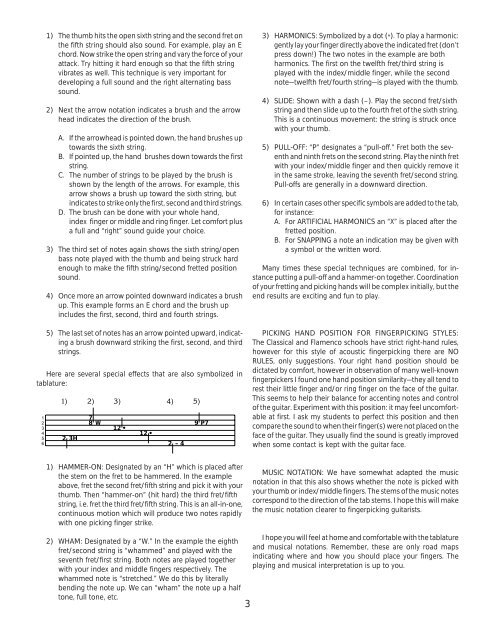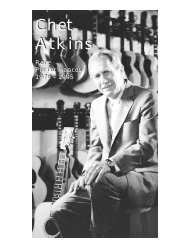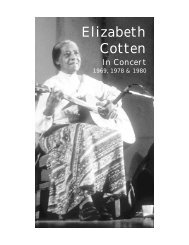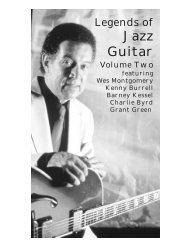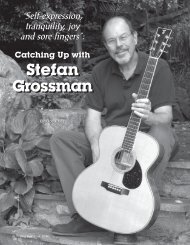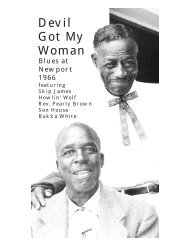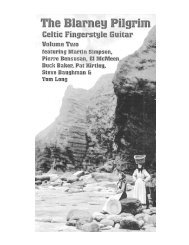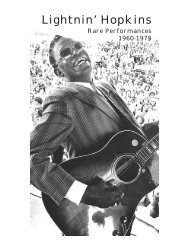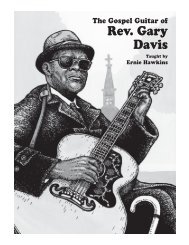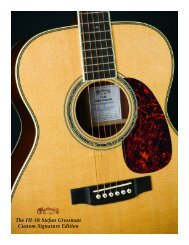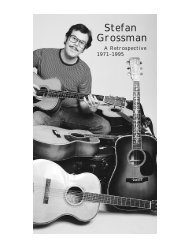Country Blues Guitar In Open Tunings - Stefan Grossman's Guitar ...
Country Blues Guitar In Open Tunings - Stefan Grossman's Guitar ...
Country Blues Guitar In Open Tunings - Stefan Grossman's Guitar ...
Create successful ePaper yourself
Turn your PDF publications into a flip-book with our unique Google optimized e-Paper software.
1234561) The thumb hits the open sixth string and the second fret onthe fifth string should also sound. For example, play an Echord. Now strike the open string and vary the force of yourattack. Try hitting it hard enough so that the fifth stringvibrates as well. This technique is very important fordeveloping a full sound and the right alternating basssound.2) Next the arrow notation indicates a brush and the arrowhead indicates the direction of the brush.A. If the arrowhead is pointed down, the hand brushes uptowards the sixth string.B. If pointed up, the hand brushes down towards the firststring.C. The number of strings to be played by the brush isshown by the length of the arrows. For example, thisarrow shows a brush up toward the sixth string, butindicates to strike only the first, second and third strings.D. The brush can be done with your whole hand,index finger or middle and ring finger. Let comfort plusa full and “right” sound guide your choice.3) The third set of notes again shows the sixth string/openbass note played with the thumb and being struck hardenough to make the fifth string/second fretted positionsound.4) Once more an arrow pointed downward indicates a brushup. This example forms an E chord and the brush upincludes the first, second, third and fourth strings.5) The last set of notes has an arrow pointed upward, indicatinga brush downward striking the first, second, and thirdstrings.Here are several special effects that are also symbolized intablature:1) 2)2 3H3) 4) 5)78 W9 P712 •12 •2 – 43) HARMONICS: Symbolized by a dot (•). To play a harmonic:gently lay your finger directly above the indicated fret (don’tpress down!) The two notes in the example are bothharmonics. The first on the twelfth fret/third string isplayed with the index/middle finger, while the secondnote—twelfth fret/fourth string—is played with the thumb.4) SLIDE: Shown with a dash (–). Play the second fret/sixthstring and then slide up to the fourth fret of the sixth string.This is a continuous movement: the string is struck oncewith your thumb.5) PULL-OFF: “P” designates a “pull-off.” Fret both the seventhand ninth frets on the second string. Play the ninth fretwith your index/middle finger and then quickly remove itin the same stroke, leaving the seventh fret/second string.Pull-offs are generally in a downward direction.6) <strong>In</strong> certain cases other specific symbols are added to the tab,for instance:A. For ARTIFICIAL HARMONICS an “X” is placed after thefretted position.B. For SNAPPING a note an indication may be given witha symbol or the written word.Many times these special techniques are combined, for instanceputting a pull-off and a hammer-on together. Coordinationof your fretting and picking hands will be complex initially, but theend results are exciting and fun to play.PICKING HAND POSITION FOR FINGERPICKING STYLES:The Classical and Flamenco schools have strict right-hand rules,however for this style of acoustic fingerpicking there are NORULES, only suggestions. Your right hand position should bedictated by comfort, however in observation of many well-knownfingerpickers I found one hand position similarity—they all tend torest their little finger and/or ring finger on the face of the guitar.This seems to help their balance for accenting notes and controlof the guitar. Experiment with this position: it may feel uncomfortableat first. I ask my students to perfect this position and thencompare the sound to when their finger(s) were not placed on theface of the guitar. They usually find the sound is greatly improvedwhen some contact is kept with the guitar face.1) HAMMER-ON: Designated by an “H” which is placed afterthe stem on the fret to be hammered. <strong>In</strong> the exampleabove, fret the second fret/fifth string and pick it with yourthumb. Then “hammer-on” (hit hard) the third fret/fifthstring, i.e. fret the third fret/fifth string. This is an all-in-one,continuous motion which will produce two notes rapidlywith one picking finger strike.MUSIC NOTATION: We have somewhat adapted the musicnotation in that this also shows whether the note is picked withyour thumb or index/middle fingers. The stems of the music notescorrespond to the direction of the tab stems. I hope this will makethe music notation clearer to fingerpicking guitarists.2) WHAM: Designated by a “W.” <strong>In</strong> the example the eighthfret/second string is “whammed” and played with theseventh fret/first string. Both notes are played togetherwith your index and middle fingers respectively. Thewhammed note is “stretched.” We do this by literallybending the note up. We can “wham” the note up a halftone, full tone, etc.3I hope you will feel at home and comfortable with the tablatureand musical notations. Remember, these are only road mapsindicating where and how you should place your fingers. Theplaying and musical interpretation is up to you.


